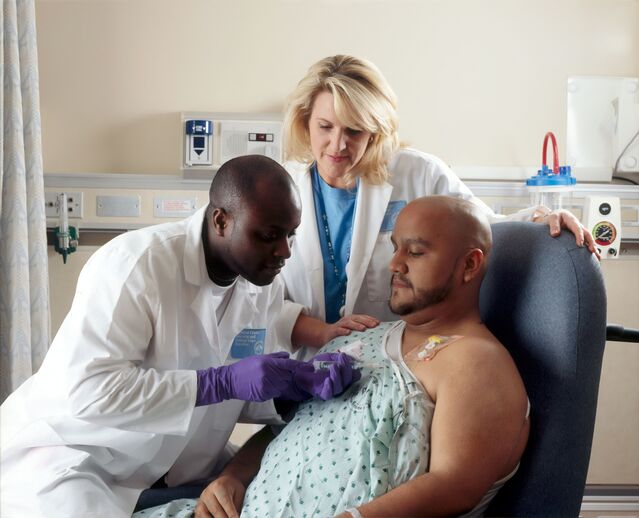Psychiatry
Mental Illness in the Emergency Room
How does the relationship between patients and staff play out in the ER?
Posted August 18, 2022 Reviewed by Lybi Ma
Key points
- Mental illness treated in the emergency room can result in distrust of medical providers.
- In some situations, there is a general sense of distrust between patients and nursing staff.
- Restructuring the emergency room could help smooth the treatment process.

The relationship between the emergency room and schizophrenia (or those with serious mental illness) is complicated and often results in undesirable outcomes.
Only patients under full throttle psychosis end up in the emergency room, and those who are lucid enough to make decisions about their care avoid it at all costs.
During one trip to the ER for allergic reactions, and upon injection of the saline solution via an IV, I immediately began hallucinating. Then it triggered the rest of my worst symptoms: PTSD flashbacks, panic attacks, and tears. What began as a friendly reassurance from the EMT staff turned into a dismal outcome. I was admitted as a trustworthy patient, but then I began turning into the typical psychiatric risk.
My psychosis got full control of me. I yelled and criticized the staff, asking for warm blankets and a therapist to help do breathing exercises with me, to no avail. The staff came in and threatened to admit me to the psychiatric unit if I “was not going to calm down and tell us what is wrong.” As a result, I lost faith in the medical team, and I was kept for five hours on site until my father came as an advocate for my discharge.
The emergency room is a busy place, and while at one time I hated physicians and believed they were out to get me, I’ve learned to adopt compassion for everyone in the environment, given that two of my cousins are emergency room doctors and nurses.
They often ask me what should be done about patients with schizophrenia. They say those admitted to the emergency room are different than me. “We see the worst of the worst,” said one cousin. The strategies that work on me don’t work on schizophrenia patients. My physician cousin even tried asking a patient to name five things in the room as a grounding strategy that I often use to help with PTSD. Predictably, it did nothing.
The staff of emergency rooms often encounter abuse, threats of escape, and violence from the patient that requires sedation. Qualitative studies that have gathered nurse perspectives of mentally ill patients in the emergency room have been done in East Asia and Westernized cultures, with shared themes.
A study done by researchers in Taiwan in 2020 conducted a qualitative survey of 14 nurses about what goes on in the minds of emergency room nurses. They found that nurses may feel untrustworthy towards psychotic-rambling patients, citing previous histories of violence as a reason to distrust treating patients who may attack the nurses during a needle injection, for example.
One nurse described a sense of loneliness and isolation from physicians. “Only nurses will step forward when an attack occurs in psychiatric patients,” stated one participant. “The security guards will arrive after support is sought, and are often at the periphery while nurses are in front restraining patients.”
Even trying to speak calmly using a therapeutic approach might not work on psychiatric patients. “I am scared my words will enrage the patient,” stated one participant. “When I talk to patients with depression about why they want to hurt themselves, they will talk, but they will say that I will not understand and start to cry. Therefore, I lack confidence.”
Sometimes nurses don’t trust patients who say they need to use the bathroom only to attempt escape. As a result, nurses don’t trust the patients that come in with serious mental illnesses.
A similar qualitative study was done in Sweden in 2020 and gathered data on nurses’ experience in the emergency room setting.
The same distrust appears in Sweden as in the Taiwan study, with one participant stating, “it becomes really difficult to know what is true or not true.”
One nurse noticed that:
This patient needs to have a calm and confident person she trusts” to work efficiently with the patient. Unfortunately, staff has only “a short time to create trust. What [the patient] needs are almost a couple of open arms and a confident person who can be receptive and tell her ‘I see how you feel, and I see that you are not feeling well.
The results indicated that nurses were ill-equipped to handle psychiatric diagnoses and often deferred responsibility to specialists who could treat each patient for their unique disorder.
Generally, nurses feel hopeless about treating patients with mental illness. Often their diagnoses get the best of the communication channel, leaving patients unresponsive to therapeutic suggestions and conversations proposed by staff. Countless conversations on the ground level in my own support groups and clinical settings have informed me that patients also experience a distrust of hospital staff when it comes to treating their illness.
The patients seen in the emergency room are a select demographic that typically consists of the most severe of cases. Those who seek hospitalization have already attempted suicide, become violent, and are essentially in the middle of an episode of their given diagnosis.
From my experience, these episodes are simply that, episodes. When they occur, they take siege on a patient’s ability to think and communicate clearly, making treating and communicating with psychiatric patients difficult. Patients are able to discuss more reasonable plans of action when they are not in the throes of psychosis or mania, but that often requires a waiting period for the episode to wear down. Recovering from an emergency room trip might take a few days as it can be just as traumatic as an episode.
While there are no industry plans for solutions, perhaps it is time as a society that we restructure our approach to staffing the emergency room. The emergency room is not equipped with emergency therapists, but maybe it should be. Or maybe the staff should learn more about psychiatric illness in their training, including disaster de-escalation often seen in therapy settings. And as a standard matter of professionalism, perhaps patients should equip themselves with better ways to communicate their needs in the emergency room setting (although this is often difficult to do when a person is not fully lucid).
Either way, some intermediary action must happen to ensure the safety of the patients and the staff so that trust is not broken and care can be delivered efficiently. Communication must happen from all avenues before understanding how the emergency room can serve our patients.
References
Holmberg, M., Hammarbäck, S., & Andersson, H. (2020). Registered nurses’ experiences of assessing patients with mental illness in emergency care: A qualitative descriptive study. Nordic journal of nursing research, 40(3), 151-161.
Chou, H. J., & Tseng, K. Y. (2020). The experience of emergency nurses caring for patients with mental illness: A qualitative study. International journal of environmental research and public health, 17(22), 8540.
Patient and Provider Perspectives on Emergency Department Care Experiences among People with Mental Health Concerns. Healthcare (Basel). 2022.




